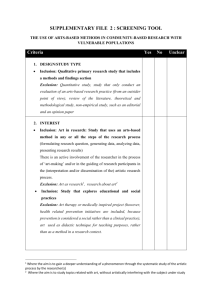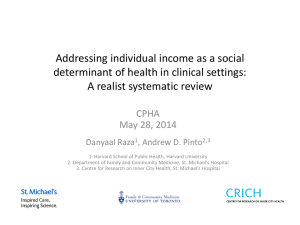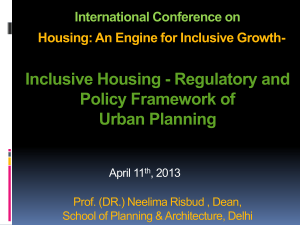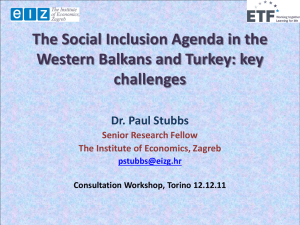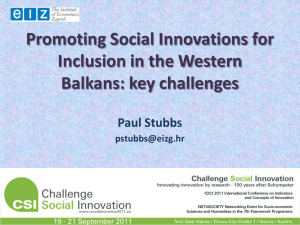A Framework of Analysis for Understanding Political Participation by
advertisement
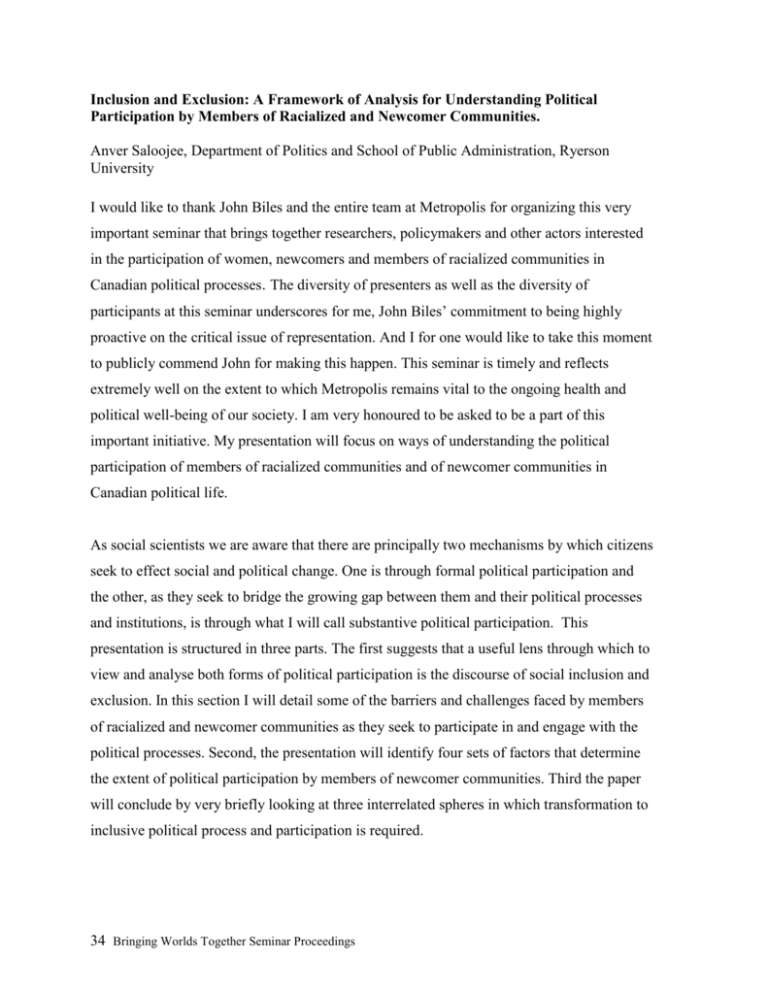
Inclusion and Exclusion: A Framework of Analysis for Understanding Political Participation by Members of Racialized and Newcomer Communities. Anver Saloojee, Department of Politics and School of Public Administration, Ryerson University I would like to thank John Biles and the entire team at Metropolis for organizing this very important seminar that brings together researchers, policymakers and other actors interested in the participation of women, newcomers and members of racialized communities in Canadian political processes. The diversity of presenters as well as the diversity of participants at this seminar underscores for me, John Biles’ commitment to being highly proactive on the critical issue of representation. And I for one would like to take this moment to publicly commend John for making this happen. This seminar is timely and reflects extremely well on the extent to which Metropolis remains vital to the ongoing health and political well-being of our society. I am very honoured to be asked to be a part of this important initiative. My presentation will focus on ways of understanding the political participation of members of racialized communities and of newcomer communities in Canadian political life. As social scientists we are aware that there are principally two mechanisms by which citizens seek to effect social and political change. One is through formal political participation and the other, as they seek to bridge the growing gap between them and their political processes and institutions, is through what I will call substantive political participation. This presentation is structured in three parts. The first suggests that a useful lens through which to view and analyse both forms of political participation is the discourse of social inclusion and exclusion. In this section I will detail some of the barriers and challenges faced by members of racialized and newcomer communities as they seek to participate in and engage with the political processes. Second, the presentation will identify four sets of factors that determine the extent of political participation by members of newcomer communities. Third the paper will conclude by very briefly looking at three interrelated spheres in which transformation to inclusive political process and participation is required. 34 Bringing Worlds Together Seminar Proceedings Inclusion and Exclusion - Anver Saloojee Social Exclusion and Inclusion: The concept of social exclusion is highly compelling because it speaks the language of oppression and enables the marginalized and the victimized to give voice and expression to the way in which they experience globalization, the way in which they experience market forces and the way in which they experience politics in a liberal democratic society. The concept of social exclusion resonates with many including those who (i) are denied access to the valued goods and services in society because of their race, gender, religion, disability etc; (ii) lack adequate resources to be effective, contributing members to the political and economic life of society; and (iii) those who are not recognized as full and equal citizens and participants in society. John Veit-Wilson distinguishes between weak versions of the social exclusion discourse which focus on changing the excluded and integrating them into society, and stronger versions of the discourse which focus on power relations between the excluded and those doing the excluding. (Viet-Wilson 1998: 45). Within these two versions one can insert an important discussion of political participation. The weak versions of the social exclusion discourse would focus simply on the exercise of the franchise as an indicator of political participation. Strong versions of the discourse would begin to assess the structural barriers to political participation by members of racialized and newcomer communities. Similarly it is important to distinguish between weak and strong versions of the social inclusion discourse. The former focus simply on political integration of the excluded (via the franchise), while strong approaches to the social inclusion discourse are intimately concerned with rights, citizenship and restructuring relations between racialized communities and the institutions of political life. In this version, the focus is on valued recognition and valued participation by those excluded from full participation in political life, excluded in the debates around public policy and excluded from enjoying the benefits of society. Madanipour et al, speak of social exclusion as a complex multi-dimensional process that combines a number of different forms of exclusion to create "acute" forms of exclusion that result in residential segregation. The forms they identify are exclusion "from decision making and political processes, access to employment and material resources, and integration into common cultural processes" Bringing Worlds Together Seminar Proceedings 35 Inclusion and Exclusion - Anver Saloojee (Madanipour et al, 1998: 22). To this list, must of necessity be added integration into common political processes as well. The origin of social exclusion terminology can be traced back to France in the early 1970s and was redefined in the 1980s as a response to the problems of sustaining adequate living conditions for those left behind by technological change, economic growth, and economic restructuring (Gore, 1995: 1; Ebersold 1998). As Gore notes, social exclusion came to refer to the "process of social disintegration", a "rupture" in the relationship between the individual and society which resulted from structural changes in the economy and seriously impeded the mobility and integration into the labour market of younger workers and created long term unemployment for unskilled workers and immigrant workers. This in turn resulted in increased social problems and a tearing of the social fabric: increased homelessness, increased tensions, and periodic violence. Social exclusion as rupture is linked to Silver's solidarity paradigm - one of three paradigms she uses to link exclusion, citizenship and social integration (Silver, 1995: 62). The French focus on adequate living standards sought to link social exclusion to poverty. Levitas notes that the term originates with a concern with poverty, inequality and restricted citizenship rights (Levitas, 1996: 7). Like Levitas, Walker and Walker are cognizant of the need to go beyond a uni-dimensional construct of social exclusion: "we have retained the distinction regarding poverty as a lack of the material resources, especially income, necessary to participate in British society and social exclusion as a comprehensive formulation, which refers to the dynamic process of being shut out, fully or partially, from any of the social, economic, political or cultural systems which determine the social integration of a person in a society. Social exclusion may therefore be seen as the denial (non-realization) of the civil, political and social rights of citizenship" (Walker and Walker, 1997: 8). For many including Walker and Walker the opposite of exclusion is integration - into the labour market or more generally into a broader conception of citizenship with an interlocking set of reciprocal rights and obligations (see Bryne, 1999: 2; Gore, 1995: 2). The opposite of political exclusion then could well refer to integration into the political process (through 36 Bringing Worlds Together Seminar Proceedings Inclusion and Exclusion - Anver Saloojee voting, through the political party system or more generally through active engagement with the policy process). Exclusion therefore is very much a lived experience and can be quantified. By 1989 European Economic Community (EEC) began to link social exclusion with inadequate realization of social rights. In 1990 the European Observatory on National Policies for Combating Social Exclusion was established to look at "the basic rights of citizenship to a basic standard of living and to participation in major social and economic opportunities in society" (Room as cited in Gore, 1995: 2). To this we must also add the importance of linking exclusion with the inadequate realization of political rights – including participation in the minor and major political opportunities in society. The link between social exclusion, citizenship and political participation hinges on the degree to which groups of individuals are denied or restricted from participating in the political life of society. The European Foundation sees social exclusion as the "process through which individuals or groups are wholly or partially excluded from full participation in the society in which they live" (European Foundation, 1995: 4). Duffy similarly notes that social exclusion refers to "the inability to participate effectively in economic social, political and cultural life, and, in some characterizations, alienation and distance from the mainstream society" (Duffy, cited by Barry, 1998: 2). In Western Europe interest in social exclusion has grown in the face of rising unemployment, increasing migration, increasing social tensions, structural adjustments resulting from the impositions of neo-liberalism. Walker is correct when he observes: "It is ironic that European discourse should have alighted on the concept of social exclusion at a time when market trends, including the creation of a single European market and currency, are generalizing more inequality and insecurity and there is an apparent loss of support for social protection" (Walker, 1997: 49). The problem is not with capitalism as an economic system that engenders significant income disparities and poverty and reproduces multiple forms of oppression and discrimination, rather the problem is the current conjuncture that tends "to exclude some groups from the cycle of opportunities" (Levitas, 1996: 8). The current preoccupation by the European Union with social exclusion is linked to the post industrial social order crisis affecting developed nations (Byrne, 1999: 3). Freiler has identified multiple and varied sources of exclusion including: Bringing Worlds Together Seminar Proceedings 37 Inclusion and Exclusion - Anver Saloojee Structural/economic (iniquitous economic conditions; low wages, dual and segregated labour markets etc); Historical oppression (colonialism); Discrimination The absence of legal/political recognition Institutional/civic non acceptance; Self-exclusion (Freiler, 2001: 13). Without undertaking an analysis of the "political economy of exclusion", the attraction of the current discourse is that it focuses attention on social exclusion as failure to integrate into the labour market. But the contemporary discourse on social exclusion is too narrowly focused on poverty and integration into the paid labour market, and it potentially obscures a bigger debate about the relationship between social exclusion and political participation. Peter Mandelson, the Minister without Portfolio in the New Labour government elected in the UK in 1997 suggested that social exclusion is "the biggest challenge we face: the growing number of our fellow citizens who lack the means, material or otherwise, to participate in economic, social, cultural and political life in Britain today: it is about more than poverty and unemployment" (cited by Barry, 1998: 4). This dynamic process of being shut out can be diagnosed and measured as patterns of exclusion which affect individuals and groups in Exclusion from goods and services; labour market exclusions; exclusion from land; exclusion from security; exclusion from human rights; exclusion from macro-economic development strategy and exclusion from participating in all facets of political and policy life in contemporary society. Racism, Social Exclusion and Political Participation. For our purposes then, social exclusion relates intimately to processes which intentionally or unintentionally restrict people's participation in the political life and in the political activities of society. As a description of a state of affairs social exclusion applied to political participation corresponds to diminished states of citizenship (broadly conceived), and diminished states of political participation and diminished access to valued political goods 38 Bringing Worlds Together Seminar Proceedings Inclusion and Exclusion - Anver Saloojee (representation, access to policy makers, etc). The discourse of social inclusion and exclusion applied to political participation forces us to consider a range of issues including: The relationship between formal citizenship and formal, or what some call passive political participation (voting); The relationship between democratic citizenship and substantive political participation (active engagement with political parties, engaging with the policy process as part of the policy community; ensuring that all have a voice in political decision making; advocating for electoral equity etc). Untangling the challenges associated with equitable representation; Assessing the relationship between the civic culture of newcomer groups and the workings of democracy in a multicultural multiracial society (Fennema and Tillie, 1999). Identifying the systemic barriers to political participation by members of racialized and newcomer communities. Assessing whether our institutions of political life equitably reflect the diversity of our societies. Learning more about patterns of diverse community participation in building social capital through volunteerism, social movements and advocacy. The political participation of immigrants in society can be seen as part of the process of social and political integration in the new society. Studies of newcomers have dealt extensively with different aspects of their integration in the new society including labour market inclusion and exclusion (Bailey and Waldinger, 1991; Portes and Jensen, 1987; Sanders and Nee, 1987), language proficiency (Espenshade and Fu, 1997) and social exclusion and social integration (Zhou and Logan, 1989). Mesch notes that the extensive literature has been dominated by the “assimilation approach” that emphasizes the role of “socio-economic status attainment and acculturation in the integration of immigrants. According to this model, the improvement in the immigrant socio-economic status allows to him/her to feel part of the mainstream of society and to attain housing and social status in the new society” (Mesch, 2002). Significantly less research has been done on the issue of the political integration of newcomers. Studies from Europe, Great Britain, the United States, Israel and Canada, suggest that in general political participation by newcomers appears to be low in most immigrant countries (Togeby, 1999, Fennema and Tillie, 1999). A number of factors account this: Bringing Worlds Together Seminar Proceedings 39 Inclusion and Exclusion - Anver Saloojee Their marginal political status; Alienation from institutions in the host country (Diel and Blohm, 2001). Discrimination and barriers to political participation; The lack of a political opportunity structure that actively encourages the participation of immigrants in politics (Bousetta, 2000); and Political parties do not do much to encourage the incorporation of new immigrants into their ranks (Anwar, 2001). Factors that determine the extent of political participation by members of racialized and newcomer communities. I suggest to you that there are four sets of factors that determine the extent of political participation by members of newcomer communities. The first set is related to individual resources, such as age, marital status, education and income. (Junn, 1999). The second set of factors that influence the political participation of immigrants is related to the trajectory of settlement and integration (Back and Soininen, 1998). These include: length of residence and language proficiency, acquisition of knowledge of the political system, the different political parties and the different tactics being used in the country for political influence (Junn, 1999). This learning process requires the knowledge of the language as a central tool for the understanding of documents, speeches and local laws. A study on immigrants’ participation in Danish local elections indicated that voting was positively related to length of stay: the longer the immigrant has been in the country, the greater the likelihood of participation in local politics (Togeby, 1999). A third set of factors relate to the relationship between formal political participation and participation in ethno-specific organizations. The research of Fennema and Tillie in Holland points to the positive correlation between formal political participation and the number of ethnic organizations (Fennema and Tillie, 1999, 2000). This network of ethnic organizations represents a form of social capital as groups that were highly organized and interrelated also reported a high degree of trust in the local government and a high level of political interest. Fennema and Tillie found a strong correlation between the number of immigrants’ organization and the level of political participation and political trust (Fennema and Tillie 40 Bringing Worlds Together Seminar Proceedings Inclusion and Exclusion - Anver Saloojee 1999). Social capital, information flows and political knowledge which derives from social and organizational networks play an important role in enhancing political participation and political mobilization (Rosenstone and Hansen, 1995). Another lengthy study on political participation by newcomer communities in Holland found that voting patterns by members of immigrant communities was “ideologically driven”, and that there was a strong relationship between participating in elections (as voters and as candidates) and the “civicness” (in Putnam’s sense of the term) of ethno-racial organizations. In analyzing the relationship between voter turn out, number of candidates per ethnic group and the number of organizations per ethnic group the researchers concluded that the “The voting turnout of Turks and the high number of Turkish councillors [compared to other newcomer communities] corresponds with a high density of organizations in Amsterdam and a strong network between organizations in the Turkish community. This finding is repeated at the national level. Our results show that … the general idea that civic community and political participation are interrelated is thus supported” (van Heesum, 2002, forthcoming). This finding was consistent with Putnam’s conclusion that a strong and vibrant civic community enhances the functioning of democracy. A fourth set of factors that either inhibit or enhance political participation by members of racialized and newcomer communities has to do with the complex interplay between social identity and the persistence and reproduction of racial oppression and discrimination. The social exclusion literature has focussed primarily on poverty and labour market exclusion. Racial discrimination is undoubtedly a form of social exclusion, albeit one that has race as a social construct, at the heart of exclusion. Its roots and manifestations however are different when compared to other forms of exclusion. Racism is unequal access to rights, it is unequal assess to the valued goods and services in society, it is about unequal access to the labour market and it extends to all fields of public life. It is about incomplete citizenship, undervalued rights, undervalued recognition and undervalued participation. Racial inequality and discrimination in Canada are historically derived, have persisted over the centuries and have been constantly reproduced in old as well as new ways. The persistence of racial inequality and racial discrimination over the centuries points to the abject failure of public Bringing Worlds Together Seminar Proceedings 41 Inclusion and Exclusion - Anver Saloojee policy and state initiatives in these areas. Patterns of inequality and discrimination generally have proved to be highly resistant to change because of the powerful socio-economic, political and ideological forces which maintain and reproduce the patterns. Inequality has become structured inequality in Canadian society and racial inequality is leading to racialized poverty. The study of structured racial inequality, discrimination, rights and privileges hinges on a recognition that in Canadian society, women, racialized individuals and communities, persons with disabilities and First Nations Aboriginal people who enter the labour market, enter the educational system, and seek goods and services (among other things) and who seek to enter the political arena, will face a structure of opportunities that are mediated by their race, gender, disability etc. Precisely because of the existence of discrimination and barriers all people in Canadian society do not start from the same spot, and do not compete on an equal footing with each other. The study of racial inequality and racial discrimination is a study of how these “consequential human differences” are structured, continually reproduced, and are used to deny people access to the valued goods and services in society. Structured racial exclusion then is the process by which individuals and groups with certain socially valued attributes are better positioned than racialized individuals and groups who do not possess or are denied the attributes, to secure a greater share of society’s valued goods, services, rewards and privileges; and to use these benefits to reinforce their control over rights opportunities and privileges in society. In so doing racial inequality and unequal access to the valued goods and services in society are structured and continually reproduced. Advantages and a disproportionate share of society’s resources are conferred on those who possess the valued attributes. In the context of formal political participation this means that the significant demographic changes in Canadian society and its urban areas, has not translated into “new political realities” nor has it altered the “balance of power holding [in political parties] between ‘insiders’ and ‘outsiders’ (Black, 2000: 8). Despite an increase in the available pool of potential candidates from racialized communities, political parties in Canada have been slow to recruit them to stand for office. Jerome Black identifies a number of structural 42 Bringing Worlds Together Seminar Proceedings Inclusion and Exclusion - Anver Saloojee barriers faced by members of racialized communities as they seek to enter the federal political arena: The recruitment process works to confer advantages on established groups. This is accomplished in two distinct ways – because they dominate among the gatekeepers and because they tend to recruit in their own images; Those who currently dominate the higher echelons of established political parties are “reluctant to share power, they do not yield their monopoly to new social groups” (Black, 2000: 8); Racial discrimination that subtly acts to exclude members of racialized communities; The continual reliance by recruiters on established networks in the British and French communities to recruit prospective candidates; and Incumbency that “works to preserve the status quo” (Black, 2000: 8-10). In recent times political parties have come to recognize the value of numbers as many of them in the midst of, or soon to be in the midst of leadership campaigns rush to sign up new members and a vast untapped pool of potential party members are to be found among the historically neglected members of racialized communities. This recognition needs to be extended. Political parties have to recognize the symbolic importance of increased representation, as Black points out, “since party allegiances are more likely to be cemented by ethnic candidates rather than overridden by them – it may help at the margins” (Black, 2000: 13). This will be particularly true in those ridings where significant residential concentration is evident. Further the party that seeks to remake itself and seeks to ensure greater diversity in its candidate pool can make greater inroads into racialized communities. At another level, one of the consequences of dealing with the effects of oppression and discrimination is that members of racialized communities and their organizations find other avenues to engage in political activity. A study by Junn found that members of historically disadvantaged racialized communities are more likely to be involved in protest and less in voting. On the other side, members of non-disadvantaged communities are more likely to be involved in electoral voting (Junn, 1999). Certainly, social identity has a direct bearing on both the form and the extent of political participation. This is the substantive dimension of political participation. Racial Bringing Worlds Together Seminar Proceedings 43 Inclusion and Exclusion - Anver Saloojee discrimination leads to incomplete citizenship and undervalued participation and undervalued recognition. The recognition of the absence of social inclusion, coupled with the reality of exclusion and discrimination then prompted a reflexive or what Castells calls a “defensive” assertion of identity (Castells, 1997). The assertion of an identity against discrimination and exclusion in turn creates a politics of inclusion and social cohesion that is no longer rooted simply in the desire to hold on to that which is unique. Rather the politics of inclusion and social cohesion cut across inter-group identity and intra-group solidarity to challenge the dominant discourse. Castells also notes that project identity that accompanies a transformative project. This occurs when social actors build a new identity that redefines their position in society and seek the transformation of overall social structure (Castells, 1997). This is what Giddens is referring to when he talks of “dialogic democracy” based on a mutual respect, a shared understanding of the effects of exclusion and marginalization and the emergence of solidarity: “Dialogic democracy…concerns furthering of cultural cosmopolitanism and is a prime building block of that connection of autonomy and solidarity…dialogic democracy encourages the democratization of democracy within the sphere of the liberal-democratic polity.” (Giddens, 112). The growth of the multicultural society therefore is producing the conditions for the emergence of a new sense of social inclusion, what David Held calls a “cosmopolitan democracy” (Held, 1995: 226-231) that recognizes differences, respects differences and that argues for substantive equality and not just formal equality. Anti-Racism, Social Inclusion and Political Participation. Social inclusion forces the discourse beyond the realm of formal political participation and into the realm of substantive political participation where the very institutions of democracy need to be democratized in response to the challenges to discrimination, exclusion and inequality. Social inclusion begins from the premise that it is democratic citizenship that is at risk when a society fails to develop the talents and capacities of all its members. The move to social inclusion is eroded when the rights of members of racialized communities are not respected and accommodated and minorities feel “Othered”. For social inclusion there is no contradiction between democratic citizenship and differentiated citizenship (where people 44 Bringing Worlds Together Seminar Proceedings Inclusion and Exclusion - Anver Saloojee can hold dual and even multiple loyalties). Democratic citizenship is about valued participation, valued recognition and belonging. At a minimum, it is characterized by: All the political rights associated with formal equality; A right to equality and a right to be free from discrimination; An intimate relationship between the individual and the community; Reciprocal relationship of rights and obligations; Barrier free access to political parties a sense of belonging and not being “othered” and marginalized; A commitment on the part of the political parties to ensure that all members of society have equal access to running for office; and Providing all members of society with the resources to exercise democratic citizenship. Advancing minority rights, it is argued by some, will have a corrosive effect on “citizenship”. It will be detrimental to the political process and the policy process. It will politicize ethnicity and race and detract from the emergence of a national identity. Further it will lead to hyphenation and ultimately only reinforce the very exclusion that minority rights advocates were fighting against. 1 In response to this argument, the Supreme Court of Canada noted that minority rights do not erode democratic citizenship, rather “The accommodation of differences is the essence of true equality” (cited by Kymlicka and Norman 1999: 33). Conclusion We share the fundamental premise, on which this seminar is built; that “In a diverse society nothing is more important than ensuring that all citizens have the opportunity to participate in the discussions that set the rules by which we agree to live. This principle was recognized in the Multiculturalism Policy in 1971 and enshrined into legislation with the passage of the Canadian Multiculturalism Act in 1988”. As this paper suggests, the realization of this goal is complex. Not only must we democratize the very institutions of Canadian democracy, we must also work strenuously to eradicate racial and other forms of discrimination and the 1 Two articles are interesting in this regard as they detail the challenges associated with what I call electoral equity in relation to political participation and group representation - Mansbridge (2000) and Williams (2000). Bringing Worlds Together Seminar Proceedings 45 Inclusion and Exclusion - Anver Saloojee attendant barriers to respected and valued political participation by members of racialized and newcomer communities. We must engage in a respectful debate about what I call electoral equity (which is the subject of another paper). There are three spheres to which our attention ought to turn. First we need to turn our attention to the sphere of formal political participation. Second we should turn to the sphere of civil society and third the sphere of political parties. In the first sphere of formal political participation, the government has a responsibility to actively encourage the widest possible political participation by members of racialized and newcomer communities. The government should work with community based organizations to reverse the trends towards voter apathy and declining voter turnouts. In this sphere political parties have a responsibility to field candidates from a wide diversity of backgrounds and ensure that they are not confined solely to the “throw away ridings”. In the second sphere the government has a responsibility to ensure the viability of organizations representing the interests of newcomer and racialized communities. If as the data suggest there is a mutually reinforcing relationship between formal political participation and the strength of community organizations, the financial and organizational well-being of the latter are essential prerequisites for a healthy democracy. In this sphere federal, provincial and municipal bureaucrats also have a responsibility to engage in meaningful consultation with civic organizations. The latter is essential to viable substantive political participation. In the third sphere political parties have a responsibility to undertake the process of organizational change. They have to take a serious look at the way in which they interact with marginalized communities; the way they recruit candidates, where they field candidates, how they recruit members etc. Politicians, gatekeepers in political parties, the leadership of political parties and senior bureaucrats all have a responsibility to begin to remedy the situation of under representation of members of racialized and newcomer communities. Failure to do so can only lead to a growing sense of frustration. Discrimination, prejudice, exclusion, marginalization in an ostensibly multicultural, multiracial society forms the context in which the search for identity and social cohesion is experienced. Representation and participation in political institutions, political processes and civic life are critical indicators of political inclusion. 46 Bringing Worlds Together Seminar Proceedings Inclusion and Exclusion - Anver Saloojee Political inclusion is precisely about the democratization of democracy. By developing a new way of approaching old problems, by positing a radically different conception of citizenship and community, by arguing for new measures of accountability, by providing the impetus for the emergences of new modes of evaluations of public policies, by arguing for increased representation and participation by marginalized groups and above all by encouraging the development and utilization of skills talents and capacities of all a commitment to political inclusion will democratize democracy. Members of racialized and newcomer communities are the latest in a long line of equity seeking groups who are tapping into the broader liberal commitment to equality and social justice. The greatest challenges posed by diversity are to build on the traditions of equality espoused in liberalism and to move from an official policy of multiculturalism to building and nurturing inclusive political processes and institutions that exemplifying our national values. Bringing Worlds Together Seminar Proceedings 47 Inclusion and Exclusion - Anver Saloojee Bibliography Abella, Rosalie Silberman, (1987), “Employment Equity-Implications for Industrial Relations", Industrial Relations Centre, Queen's University, 1987. Agocs, C., et al, (1992), Employment Equity, Toronto, Prentice Hall Canada. Alba, R., and Nee V. (1997). Rethinking assimilation theory for a new era of immigration. International Migration Review. 31(4),826-874. Anderson, a., and J. Freideres, Ethnicity in Canada: Theoretical Perspectives, Toronto, Butterworths. Anwar M. (2001). The participation of ethnic minorities in British politics. Journal of Ethnic and Migration Studies. 27 (3),533-549. Back, H. and Soininen M. (1998). Immigrants in the political process. Scandinavian Political Studies. 21:29-50. Bailey, T. and Waldinger R. (1991). Primary, secondary and enclave labour markets: a training systems approach. American Sociological Review. 56,432-445 Banton, M., The Idea of Race, London, Tavistock Publications. Barata, P., (2000), Social Exclusion: A Review of the Literature. Background Paper prepared for Laidlaw Foundation, Toronto. Barry, M., (1998), ‘Social Exclusion and Social Work: An Introduction’, in M. Barry and C. Hallett (eds.) Social Exclusion and Social Work, Dorset, Russel, House Publishing Ltd. Benick, G., and A. Saloojee, “Introduction” in G. Benick and A. Saloojee (1996), Creating Inclusive Post-Secondary Learning Environment, Toronto. Bhinder v. Canadian National Railways (1981), 2 C.H.R.R.D.\546 at D\S 9991. Bibby, R., Mosaic Madness, The Potential and Poverty of Canadian Life, Toronto, Stoddard. Billingingsley, B., and L Musynzski, (!985), No Discrimination Here, Toronto, Urban Alliance on Race Relation. Black, J., (2000), “Minority Representation in the Canadian Parliament Following the 1997 Election: Patterns of Continuity and Change”. Presented at the Fourth National Metropolis Conference, Toronto, March, 2000. Bonacich, E., (1972), “A Theory of Ethnic Antagonism: The Split Labour Market”, American Sociological Review, 37: 547-559. 48 Bringing Worlds Together Seminar Proceedings Inclusion and Exclusion - Anver Saloojee Bousetta, H. (2000). “Institutional theories of immigrant ethnic mobilization: relevance and limitations”, Journal of Ethnic and Migration Studies. 26(2), 229-245. Byrne, D., (1999), Social Exclusion, Buckingham, Open University Press. Canadian Council of Christians and Jews, Attitudes Towards Race and Ethnic Relations, 1993. Canadian Race Relation Foundation (2000), Unequal Access: A Canadian Profile of Racial Differences in Education, Employment and Income, Canada, Canadian Race Relations Foundation. Carey, E., (2002), “Jobs Tougher to find for recent immigrants”, Toronto Star, February 26, 2002. Castells, M., (1978), City Class and Power, London, The Macmillan Press. Castells, M., (1979), The Urban Question: a Marxist Approach, Cambridge, MIT Press. Castells., M., (1996) The Rise of the Network Society, Oxford: Blackwell. Castells, M., (1997), The Power of Identity, Oxford, Blackwell Publishers. C.N.R. v. Canada (Human Rights Commission) ,[1987] 1 S.C.R.1114. Cox, O. (1948), Caste, Class and Race, New York, Doubleday and Co. Inc. Diehl, C. and Blohm, M. (2001). “Apathy, adaptation or ethnic mobilization? On the attitudes of a politically excluded group”, Journal of Ethnic and Migration Studies 27(3),401-420. Dreidger, L., (1989), The Ethnic Factor: Identity in Diversity, Toronto, McGraw Hill Ryerson. Ebersold, S., (1998), Exclusion and Disability, Organization for Economic Co-operation and Development: Centre for Educational Research and Innovation, on the OECD web site: http//www.oecd.org/els/edu/ceri/conf220299.html. Employment and Immigration Canada, Immigration to Canada: Issues for Discussion, 1989. Espenshade, T. and Fu H. (1997). “An analysis of English language proficiency among U.S. immigrants”, American Sociological Review 62(2),288-305. European Foundation for the Improvement of Living and Working Conditions (1995), Public Welfare services and Social Exclusion: The Development of Consumer Oriented Bringing Worlds Together Seminar Proceedings 49 Inclusion and Exclusion - Anver Saloojee Initiatives in the European Union, Dublin, The Foundation. Fenema, M. and Tillie, J. (1999). “Political participation and political trust in Amsterdam: civic communities and ethnic networks”, Journal of Ethnic and Migration Studies. 25(4), 703-726. Fenema, M. and Tillie, J. (2001) “Civic community, political participation and political trust of ethnic groups”, Connection, 23 (2) 44-59. Fleras, A., and L.J. Elliott, (1992), Muticulturalism in Canada: The challenge of Diversity, Toronto: Oxford. Frank, J., (1997), “Indicators of Social Inequality in Canada: Women, Aboriginal People and Visible Minorities, in A. Frizzell and J. Pammett (eds.), Social Inequality in Canada, Ottawa, Carleton University Press. Freideres, J., (1999), Unequal Relations: An Introduction to Race, Ethnic, and Aboriginal Dynamics in Canada. Scarborough: Prentice Hall Allynand Bacon Canada. Fraser, N., (1996), “Rethinking the Public Sphere: A contribution to the Critique of Actually Existing Democracies” in C. Calhoun, (ed)., Habermas and the Public Sphere, Cambridge Mass.: MIT Press. Freiler, C., (2001), “What Needs to Change?: Social Inclusion as a Focus of Well Being for Children, Families and Communities – A Draft Paper Concept”, Laidlaw Foundation, Toronto. Galabuzi, Grace –Edward, (2000), Canada’s Creeping Economic Apartheid, Canada, Canadian Race Relations Foundation. Giddens, A., Beyond Left and Right, Cambridge: Polity Press. Gore, C., (1995), “Introduction, Markets and Citizenship” in G. Rodgers et al, Social Exclusion: Rhetoric, Reality Responses, Geneva, ILO Publications. Harvey, D., (1976), Social Justice and the City, London, Edwin Arnold. Harvey, D., (1989) The Conditions of Post Modernism, Oxford, Blackwell. Harvey, D., (1996), Justice, Nature and the Geography of Difference, Oxford: Blackwell. Held, D., (1995), Democracy and the Global Order: From the Modern State to Cosmopolitan Governance, Cambridge: Polity Henry, F., et al, (1995) The Colour of Democracy, Toronto, Harcourt, Brace and Company. 50 Bringing Worlds Together Seminar Proceedings Inclusion and Exclusion - Anver Saloojee Henry, F., and E. Ginsberg (1985), Who Gets the Work? A Test of Racial Discrimination in Employment, Toronto, The Social Planning Council of Toronto. Holston, J., (1995), “Spaces of Insurgent Citizenship”, in Planning Theory, (Special Issue), 35-52. Hou, F., and T. R. Balakrishnan (1996), “The Integration of Visible Minorities in Contemporary Canadian Society”, Canadian Journal of Sociology, 21(3): 307-326. Jackson, A., (2001), “Poverty and Racism” in Perception, 24(4), 6-7. Junn, J. (1999). “Participation in liberal democracy: the political assimilation of immigrants and ethnic minorities in the U.S”, American Behavioral Scientist 42(9),1417-1438. Kymlicka, W., and W. Norman, (2000), “Citizenship in Culturally Diverse Societies: Issues, Contexts and Concepts” in Kymlicka, W., and W. Norman, Citizenship in Divided Societies, Oxford, Oxford University Press. Li, P., (1998), “The Market Value and Social Value of Race” in V. Satzewich, (ed.), Racism and Social Inequality in Canada: Concepts, Controversies and Strategies of Resistance, Toronto, Thompson Educational Publishing, Inc. Levitas, R., (1996), ‘The Concept of Social Exclusion and the New Durkheimian Hegemony’, in Critical Social Policy, No 16 (1), pp. 5-20. Mansbridge, J., (2000), “What does a Representative Do? Descriptive Representation in Communicative settings of Distrust, Uncrystallized Interests, and Historically Denigrated Status” in Kymlicka and Norman, op. cit. Mesch, G., (2002), “Residential Concentration and Participation in Local Politics: The case of Immigrants of the FSU in Israel” n.p. Ministry of Citizenship, 1989, A Theoretical Context for Employment Equity, Toronto. Novick, M., (2001), Social Inclusion: The Foundation of a National Policy Agenda. The Laidlaw and Canadian Council on Social Development Conference: “A New Way Of Thinking? Towards A Vision of Social Inclusion”, Ottawa, November 2001. Office of the Employment Equity Commissioner, (1991), Working Towards Equality, Ministry of Citizenship, Toronto, Government of Ontario. Ontario Human Rights Commission (1983), The Experience of Visible Minorities in the Work World: the Case of MBA Graduates, Ontario, Ontario Human Rights Commission. Ornstein, M., (2000), Ethno-Racial Inequality in Toronto: Analysis of the 1996 Census, Toronto, City of Toronto. Bringing Worlds Together Seminar Proceedings 51 Inclusion and Exclusion - Anver Saloojee Phillips, A., (1999), Which Equalities Matter? Cambridge, Polity Press. Portes, A. and Jensen L. (1987). “Limits of ethnic solidarity in the enclave economy”, American Sociological Review. 52 (6),745-767. Ramakrishnan, S. K. and Espenshade, T.J. 2001. “Immigrant incorporation and political participation in the U.S”, International Migration Review, 35, 3,870-909. Rodgers, G., (1995), “What is special about a “Social Exclusion” Approach?” in Rodgers, et al, op. cit. Room, G., (1995), ‘Poverty and Social Exclusion: The European Agenda for Policy and Research’ in G. Room, Beyond the Threshold: the Measurement and Analysis of Social Exclusion, Bristol, The Policy Press. Rosenstone, S.J. and Hansen, M. 1993. Mobilization, Participation and Democracy in America. New York: Macmillian Publishing Co. Saloojee, A., (1996) Issues in Equity and Human Rights: A Distance Education Workbook, Toronto, Ryerson University. Saloojee, A., “Social Inclusion, Citizenship and Diversity: Moving Beyond the Limits of Multiculturalism”. Presented at the CCSD-Laidlaw Foundation Conference, A New Way of Thinking? Towards, A Vision of Social Inclusion, Ottawa, November, 2001. Sandercock, L., (1998), Towards Cosmopolis, West Sussex, John Wiley & Son. Sanders, J.M. and Nee V. (1987). Limits of ethnic solidarity in the enclave economy. American Sociological Review. 52,745-767. Saunders, P., (1981), Social Theory and the Urban Question, London: Hutchinson Siemiatycki M., A. Saloojee (2001), Ethno-Racial Political Representation in Toronto: Patterns and Problems. Presented at the Metropolis International Conference, Rotterdam, November, 2001. Smith, E., Andrew Jackson, (2002), Does a Rising Tide Lift All Boats?The Labour Market Experiences and Incomes of Recent Immigrants ,1995 to 1998, CCSD, OTTAWA. Statement by the Prime Minister in the House of Commons, October 8, 1971 Togeby, L. (1999). “Migrants at the polls: an analysis of immigrants and refugee participation in Danish local politics”, Journal of Ethnic and Migration Studies. 25(4),665-685. 52 Bringing Worlds Together Seminar Proceedings Inclusion and Exclusion - Anver Saloojee Toronto Star, 24/2/93; 21/3/94; 22/3/94; 7/6/99. United Nations, (1965), International Convention on the Elimination of all Forms of Racial Discrimination, New York, United Nations. van Heesum, A., (2001), “The Relatioship Between Political Participation and Civic Community of Migrants in the Netherlands”. Presented at the Metropolis International Conference, Rotterdam, November 2001. Veit-Wilson, J., (1998), Setting Adequacy Standards, Bristol, Policy Press. Walker, A., and C. Walker (eds.), (1997), Britain Divided: The Growth of Social Exclusion in the 1980s and 1990s, London, Child Poverty Action Group. Walker, R., “Poverty and Social Exclusion in Europe” in ibid. Weinfeld, M., (1981)., “Canada”, in R. G. Wirsing (ed.), Protection of Ethnic Minorities, New York: Pergamon Press. 41-78. Williams, M. S., (2000), “The Uneasy Alliance of Group Representation and Deliberative Democracy” in Kymlicka and Normand, op. cit. Zhou, M. and Logan, J.R. (1989). “Returns to human capital in ethnic enclaves: New York City's Chinatown”, American Sociological Review, 54,809-820. Bringing Worlds Together Seminar Proceedings 53
